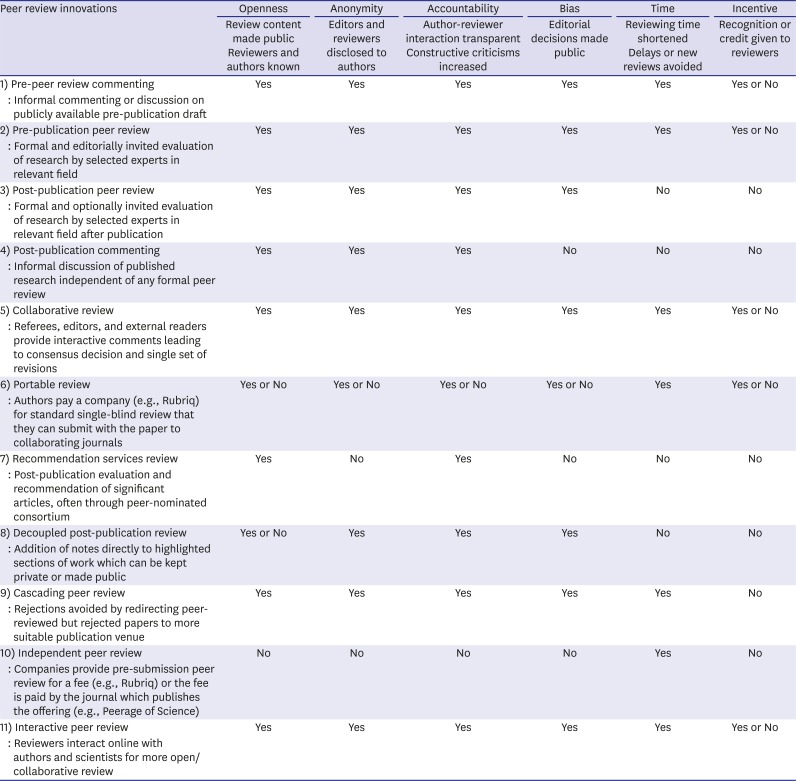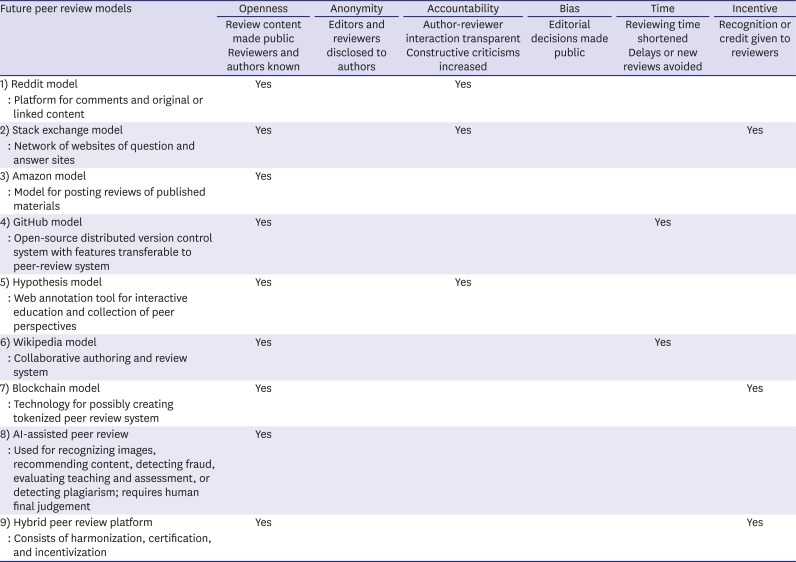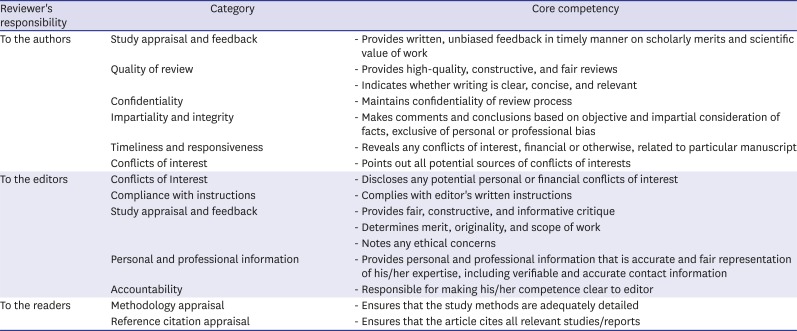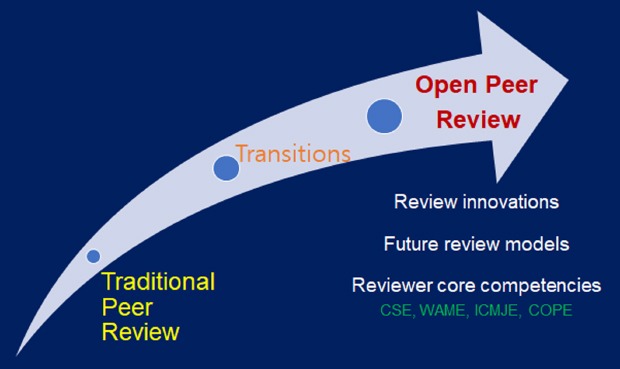1. Stahel PF, Moore EE. Peer review for biomedical publications: we can improve the system. BMC Med. 2014; 12(1):179. PMID:
25270270.

2. Björk BC, Catani P. Peer review in megajournals compared with traditional scholarly journals: does it make a difference? Learn Publ. 2016; 29(1):9–12.

3. Barroga EF. Safeguarding the integrity of science communication by restraining ‘rational cheating’ in peer review. J Korean Med Sci. 2014; 29(11):1450–1452. PMID:
25408573.

4. Teixeira da Silva JA. Challenges to open peer review. Online Inf Rev. 2019; 43(2):197–200.

5. Bourke-Waite A. Innovations in scholarly peer review at Nature Publishing Group and Palgrave Macmillan. Insights. 2015; 28(2):93–99.

7. Tennant JP, Dugan JM, Graziotin D, Jacques DC, Waldner F, Mietchen D, et al. A multi-disciplinary perspective on emergent and future innovations in peer review. F1000 Res. 2017; 6:1151.

8. Gasparyan AY, Ayvazyan L, Blackmore H, Kitas GD. Writing a narrative biomedical review: considerations for authors, peer reviewers, and editors. Rheumatol Int. 2011; 31(11):1409–1417. PMID:
21800117.

9. Gregory AT, Denniss AR. Everything you need to know about peer review — the good, the bad and the ugly. Heart Lung Circ. 2019; 28(8):1148–1153. PMID:
31230792.

10. Misra DP, Ravindran V, Agarwal V. Integrity of authorship and peer review practices: challenges and opportunities for improvement. J Korean Med Sci. 2018; 33(46):e287. PMID:
30416407.

11. Ross-Hellauer T, Görögh E. Guidelines for open peer review implementation. Res Integr Peer Rev. 2019; 4(1):4. PMID:
30858990.

13. Van Noorden R. Company offers portable peer review. Nature. 2013; 494(7436):161. PMID:
23407520.

14. Barroga EF. Cascading peer review for open-access publishing. Eur Sci Ed. 2013; 39(4):90–91.
15. Hames I. The changing face of peer review. Sci Ed. 2014; 1(1):9–12.

17. Horbach SP, Halffman W. Journal peer review and editorial evaluation: Cautious innovator or sleepy giant. Minerva. 2019.

18. Horbach SPJM, Halffman W. The changing forms and expectations of peer review. Res Integr Peer Rev. 2018; 3(1):8. PMID:
30250752.

25. Warne V. Rewarding reviewers – sense or sensibility? A Wiley study explained. Learn Publ. 2016; 29(1):41–50.

26. Willis M. Why do peer reviewers decline to review manuscripts? A study of reviewer invitation responses. Learn Publ. 2016; 29(1):5–7.

27. Nguyen VM, Haddaway NR, Gutowsky LF, Wilson AD, Gallagher AJ, Donaldson MR, et al. How long is too long in contemporary peer review? Perspectives from authors publishing in conservation biology journals. PLoS One. 2015; 10(8):e0132557. PMID:
26267491.

29. Ahmed HS, Gasparyan AY. Criticism of peer review and ways to improve it. Eur Sci Ed. 2013; 39(1):8–10.
30. Steel G, Price A, Seth B, Biswas R, Chatterjee P. . Charity is welcome: the international benefits and pitfalls of peer review. PeerJ PrePrints. 2016; 4:e1585v2.

31. Gasparyan AY, Gerasimov AN, Voronov AA, Kitas GD. Rewarding peer reviewers: maintaining the integrity of science communication. J Korean Med Sci. 2015; 30(4):360–364. PMID:
25829801.
32. Garg PK. Financial incentives to reviewers: double-edged sword. J Korean Med Sci. 2015; 30(6):832–833.

33. Gasparyan AY, Ayvazyan L, Akazhanov NA, Kitas GD. Self-correction in biomedical publications and the scientific impact. Croat Med J. 2014; 55(1):61–72. PMID:
24577829.

34. Nicholas D. Advances in standards and training for journal editors and peer reviewers. Eur Sci Ed. 2018; 44(2):26–27.
40. Walker R, Rocha da Silva P. Emerging trends in peer review-a survey. Front Neurosci. 2015; 9:169. PMID:
26074753.

41. Rivera H. Fake peer review and inappropriate authorship are real evils. J Korean Med Sci. 2018; 34(2):e6. PMID:
30636943.

42. Ross-Hellauer T. What is open peer review? A systematic review. F1000 Res. 2017; 6:588.

43. Schmidt B, Ross-Hellauer T, van Edig X, Moylan EC. Ten considerations for open peer review. F1000 Res. 2018; 7:969.

44. Ross-Hellauer T, Deppe A, Schmidt B. Survey on open peer review: attitudes and experience amongst editors, authors and reviewers. PLoS One. 2017; 12(12):e0189311. PMID:
29236721.

45. Kowalczuk MK, Dudbridge F, Nanda S, Harriman SL, Patel J, Moylan EC. Retrospective analysis of the quality of reports by author-suggested and non-author-suggested reviewers in journals operating on open or single-blind peer review models. BMJ Open. 2015; 5(9):e008707.

46. Teixeira da Silva JA, Al-Khatib A. Should authors be requested to suggest peer reviewers? Sci Eng Ethics. 2018; 24(1):275–285. PMID:
28155093.

47. Horbach SP, Halffman W. The ability of different peer review procedures to flag problematic publications. Scientometrics. 2019; 118(1):339–373. PMID:
30930504.

48. Ali PA, Watson R. Peer review and the publication process. Nurs Open. 2016; 3(4):193–202. PMID:
27708830.









 PDF
PDF Citation
Citation Print
Print




 XML Download
XML Download